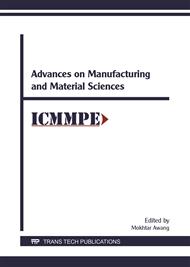p.3
p.9
p.17
p.25
p.31
p.41
p.48
p.54
Environmental Effect on Short-Beam Composite under Three-Point Bending Test
Abstract:
The effect of moisture, water absorption on a single short span beam of glass fiber reinforced polymer (GFRP) was examined under room temperature, 27°c. The aim of the study is to investigate the mechanical properties of composite under wet condition. The composite were cut into rectangular shape with a dimension of 78 mm long, 26 mm width and 3.5 mm depth. The moisture content of eight specimens was experimentally reduced as the glass fiber content increased. In this investigation, the flexural strength and modulus of composites were determined throughout the three-point bending test. The specimens were rigged up horizontally as supported beams and loaded vertically at the geometric center. Thus, the results were developed into loading versus deflection and relationship for each specimen. The samples were considered to have failed when the curves were in steady decline section. Failure mechanisms were observed in categories; face yield, core yield and fiber tear.
Info:
Periodical:
Pages:
17-24
Citation:
Online since:
June 2017
Authors:
Price:
Сopyright:
© 2017 Trans Tech Publications Ltd. All Rights Reserved
Share:
Citation:


